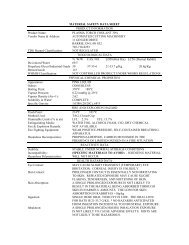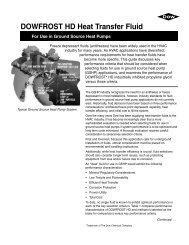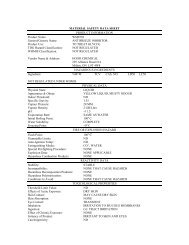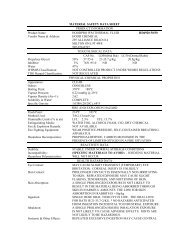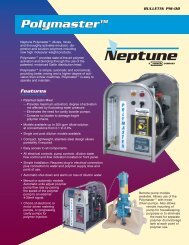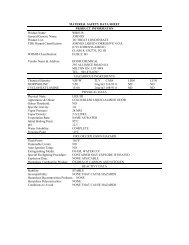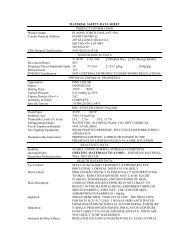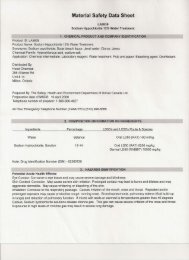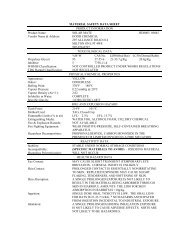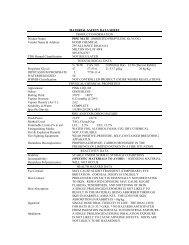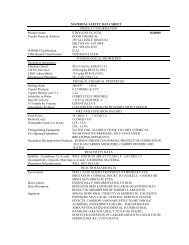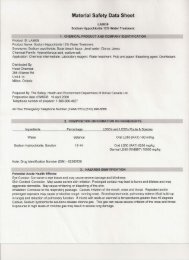MSDS - LA2201 Acetic acid 99.5% glacial - Hood Chemical
MSDS - LA2201 Acetic acid 99.5% glacial - Hood Chemical
MSDS - LA2201 Acetic acid 99.5% glacial - Hood Chemical
You also want an ePaper? Increase the reach of your titles
YUMPU automatically turns print PDFs into web optimized ePapers that Google loves.
QRDER NO:19182061 MATERIAL SAFETY DATA SHEET<br />
CUST:HOOD CHEMICALS (917617 ON<br />
<strong>MSDS</strong> NO:<strong>LA2201</strong><br />
VERSION:002 10/21/08<br />
una<br />
Material Safety Data Sheet<br />
<strong>LA2201</strong><br />
<strong>Acetic</strong> <strong>acid</strong> <strong>99.5%</strong> <strong>glacial</strong><br />
I· "..'~J
ORDER NO:19182061<br />
MATERIAL SAFETY DATA SHEET<br />
CUST:HOOD CHEMICALS (917617 ON<br />
<strong>MSDS</strong> NO:<strong>LA2201</strong><br />
VERSION:002 10/21/08<br />
I<br />
4. FIRST AID MEASURES<br />
Eye Contact: In case of contact, or suspected contact, immediately flush eyes with plenty of water for at least 15 minutes<br />
and get medical attention immediately after flushing.<br />
Skin Contact: In case of contact, immediately flush skin with plenty of water for at least 15 minutes. Get medical attention.<br />
Remove contaminated clothing and launder before reuse. Remove contaminated shoes and discard.<br />
Inhalation: If inhaled, remove to fresh air. If not breathing, give artificial respiration. If breathing is difficult, give oxygen. If<br />
the heart has stopped, trained personnel should begin cardiopulmonary resuscitation (CPR) immediately. Get medical<br />
attention immediately.<br />
Ingestion: Do NOT induce vomiting. Never give anything by mouth to an unconscious or convulsing person. Seek<br />
immediate medical attention. If vomiting occurs spontaneously, keep head below hips to prevent aspiration of liquid into<br />
the lungs.<br />
Notes to Physician: Treatment based on sound judgment of physician and individual reactions of patient. Observe for<br />
pulmonary edema.<br />
r<br />
5. FIRE FIGHTING MEASURES<br />
Flash Point: 39°C / 103 OF<br />
Flash Point Method: Closed cup.<br />
Autoignition Temperature: 516°C / 961°F<br />
Flammable Limits in Air (%): Lower: 4 Upper: 16<br />
Extinguishing Media: Use DRY chemicals, C02, alcohol foam or water spray.<br />
Special Exposure Hazards: Isolate and restrict area access. Stop leak only if safe to do so. Stay upwind. Water run-off<br />
and vapour cloud may be corrosive. Containers exposed to intense heat from fires should be cooled with water to prevent<br />
vapour pressure build-Up which could result in container rupture. Water may be used to flush spills away from fire<br />
exposures and to dilute spills to non-flammable mixtures. Water streams should not be directed to the liquid, as this will<br />
cause the liquid to boil and generate more vapour. Dike and collect water used to fight fire for neutralization before<br />
release.<br />
Hazardous Decomposition/Combustion Materials (under fire conditions): Carbon monoxide. Carbon dioxide. Toxic<br />
fumes.<br />
Special Protective Equipment: Fire fighters should wear full protective clothing, including self-contained breathing<br />
equipment.<br />
NFPA RATINGS FOR THIS PRODUCT ARE: HEALTH 3, FLAMMABILITY 2, INSTABILITY 0<br />
HMIS RATINGS FOR THIS PRODUCT ARE: HEALTH 3, FLAMMABILITY 2, REACTIVITY 0<br />
[ 6. ACCIDEN'tAL RELEASE MEASURES<br />
Personal Precautionary Measures: Wear appropriate protective equipment. Isolate for 800 metres or 0.5 miles in all<br />
directions if tank, rail car, or tank truck is involved in fire. Evacuate downwind areas as conditions warrant to prevent<br />
exposure and to allow vapours or fumes to dissipate. Spills may expose downwind areas to toxic or flammable<br />
concentrations over considerable distances in some cases.<br />
Environmental Precautionary Measures: Prevent entry into sewers or streams, dike if needed.<br />
Procedure for Clean Up: Eliminate all ignition sources. Contain spill by diking. If fire potential exists, blanket spill with<br />
alcohol type aqueous film-forming foam or use water fog stream to disperse vapours. Neutralize the residue with sodium<br />
carbonate or crushed limestone. Absorb with an inert dry material and place in an appropriate waste disposal container.<br />
Flush area with water to remove trace residue.<br />
7. HANDLING AND STORAGE "1<br />
Handling: Use with ad;quate ventilation. Keep the containers closed when not in use. Handle and open containers with<br />
care. Avoid breathing vapor. Avoid contact with eyes, skin and clothing. Fixed equipment as well as transfer containers<br />
and equipment should be grounded to prevent accumulation of static charge. Do not cut, drill, grind, weld or perform<br />
similar operations on or near containers. Empty containers may contain hazardous product residues. Wash thoroughly<br />
after handling. Protect from freezing.<br />
Storage: Store in a cool, dry, well ventilated area, away from heat and ignition sources. Place away from incompatible<br />
materials. Store in accordance with good industrial practices. Keep containers tightly closed. Store out of direct sunlight<br />
and on an impermeable floor.<br />
<strong>LA2201</strong><br />
<strong>Acetic</strong> <strong>acid</strong> <strong>99.5%</strong> <strong>glacial</strong><br />
Page 2 of 6
ORDER NO:19182061<br />
MATERIAL SAFETY DATA SHEET<br />
CUST:HOOD CHEMICALS (917617 ON<br />
<strong>MSDS</strong> NO:<strong>LA2201</strong><br />
VERSION:002 10/21/08<br />
I 8. EXPOSURE CONTROLS/PERSONAL PROTECTION<br />
Engineering Controls:<br />
Local exhaust ventilation as necessary to maintain exposures to within applicable limits.<br />
Respiratory Protection: Based on workplace contaminant level and working limits of the respirator, use a respirator<br />
approved by NIOSH. The following is the minimum recommended equipment for an occupational exposure level.<br />
For concentrations> 1 and < 10 times the occupational exposure level: Use air-purifying respirator with full face piece and<br />
organic vapor cartridge(s) or air-purifying full facepiece respirator with an organic vapor canister or a full facepiece<br />
powered air-purifying respirator fitted with organic vapor cartridge(s). The air purifying element must have an end of<br />
service life indicator, or a documented change out schedule must be established. Otherwise, use supplied air.<br />
For concentrations more than 10 times the occupational exposure level and less than the lower of either 100 times the<br />
occupational exposure level or the IDLH: Use Type C full face piece supplied-air respirator operated in positive-pressure or<br />
continuous-flow mode.<br />
For concentrations> 100 times the occupational exposure level or greater than the IDLH level or unknown concentrations<br />
(such as in emergencies): Use self-contained breathing apparatus with full facepiece in positive-pressure mode or Type C<br />
positive-pressure full facepiece supplied-air respirator with an auxiliary positive-pressure self-contained breathing<br />
apparatus escape system.<br />
For escape: Use self-contained breathing apparatus with full facepiece or any respirator specifically approved for escape.<br />
Gloves:<br />
Appropriate chemical resistant gloves should be worn. Neoprene gloves.<br />
Skin Protection: Skin contact should be prevented through the use of suitable protective clothing, gloves and footwear,<br />
selected for conditions of use and exposure potential. Consideration must be given both to durability as well as permeation<br />
resistance.<br />
Eyes: <strong>Chemical</strong> goggles; also wear a face shield if splashing hazard exists.<br />
Other Personal Protection Data: Ensure that eyewash stations and safety showers are proximal to the work-station<br />
location.<br />
Ingredients Exposure Limit - ACGIH Exposure Limit - OSHA Immediately Dangerous<br />
to Life or Health - IDLH<br />
<strong>Acetic</strong> Acid 15 ppm STEL 10 ppm TWA 50 ppm<br />
10 ppm TLV-TWA 25 mq/m 3 TWA<br />
I 9. PHYSICALAND CHEMICAL PROPERTIES<br />
Physical State: Liquid.<br />
Colour: Colourless<br />
Odour: Strong Acrid Vinegar Smell<br />
pH 2.4 (1% soln)<br />
Specific Gravity: 10492 @ 20°C<br />
Boiling Point: 118°C / 244 of<br />
Freezing/Melting Point: 16.6 -c /63 OF<br />
Vapour Pressure: 11 mmHg @ 20°C<br />
Vapour Density: 2.1<br />
% Volatile by Volume: Not Available.<br />
Evaporation Rate: 0.97<br />
Solubility: Completely soluble.<br />
VOCs: Not Available.<br />
Viscosity: Not Available.<br />
Molecular Weight: 60.05<br />
Other: Not Available.<br />
I 10. STABILIITY AND REACTIVITY<br />
<strong>Chemical</strong> Stability: Stable.<br />
Hazardous Polymerization: Will not occur.<br />
Conditions to Avoid: Avoid excessive heat, open flames and all ignition sources.<br />
Materials to Avoid: Strong oxidizing agents. Strong alkalis. Common metals and their alloys. Aldehydes. Ammonium<br />
nitrate. Sodium peroxide. Carbonates. Hydroxides. Oxides. Phosphates. Perchloric <strong>acid</strong>.<br />
Hazardous Decomposition Products: Oxides of carbon. Irritating vapors. Toxic fumes.<br />
Additional Information:<br />
<strong>LA2201</strong><br />
<strong>Acetic</strong> <strong>acid</strong> <strong>99.5%</strong> <strong>glacial</strong><br />
Page 3 of 6
ORDER NO:19182061 MATERIAL SAFETY DATA SHEET <strong>MSDS</strong><br />
CUST:HOOD CHEMICALS (917617 ON VERSION:O<br />
NO:<strong>LA2201</strong><br />
02 10/21/08<br />
"<br />
,<br />
10. STABILITY AND REACTMTY<br />
No additional remark.<br />
,<br />
11. TOXICOLOGICAL1NFORMATION<br />
Principle Routes of Exposure<br />
Ingestion: Causes digestive tract burns. Symptoms of exposure may include: Inflammation of mouth, throat, esopha gus<br />
and/or stomach. Nausea, vomiting, loss of appetite, gastrointestinal irritation and/ or diarrhea.<br />
Skin' Contact: Causes burns. Harmful if absorbed through the skin. Symptoms of exposure may include: Redness or<br />
discoloration, swelling, itching, burning or blistering of skin. Prolonged or repeated contact may cause skin sensitizati on.<br />
Inhalation: Symptoms of exposure may include; nasal discharge, hoarseness, coughing, chest pain and breathing<br />
difficulty. Accumulation of fluid in the lungs (pulmonary edema) may occur.<br />
Eye Contact: Causes severe eye burns. May cause permanent eye damage. Symptoms of exposure may include: eye<br />
irritation, burning sensation, pain, watering and/or change of vision.<br />
Additional Information: Overexposure (prolonged or repeated exposure) may cause: injury to the eyes, digestive tract<br />
damage, respiratory tract damage, skin damage.<br />
Acute Test of Product:<br />
Acute Oral LD50: Not Available.<br />
Acute Dermal LD50: Not Available.<br />
Acute Inhalation LC50: Not Available.<br />
Carcinogenicity:<br />
Ingredients IARC - Carcinogens I ACGIH - Carcinogens<br />
<strong>Acetic</strong> Acid Not listed. I Not listed.<br />
"<br />
Carcinogenicity Comment: No additional information available.<br />
Reproductive Toxicityl Teratogenicityl Embryotoxicityl Mutagenicity: Mixed results in vitro (negative in the Ame sand<br />
Chinese hamster ovary assay; positive in human lymphocytes for SCEs and in some DNA damage assays). The pos itive<br />
results are thought to be due to artifacts caused by <strong>acid</strong>ification of the culture media.<br />
I 12. ECOLOGICAL INFORMATION<br />
;'<br />
Ecotoxicological Information:<br />
Ingredients Ecotoxicity - Fish Species !Acute Crustaceans Toxicity: Ecotoxicity - Freshw<br />
Data Alqae Data<br />
<strong>Acetic</strong> Acid LC50 (Lepomis macrochirus) Not Available. Not Available.<br />
75 mg/L<br />
LC50 (Pimephales promelas)<br />
88 rnq/l,<br />
ater<br />
Other Information:<br />
Ecotoxicity: The aquatic toxicity and biodegradation of acetic <strong>acid</strong> are expected to be influenced by its potential to lower<br />
pH.<br />
Degradation: <strong>Acetic</strong> <strong>acid</strong> will biodegrade readily if released to water (e.g., 5-Day BOD's 63-81%) or soil. The atmosp heric<br />
photochemical degradation half-life is estimated to be 26.7 days.<br />
Bioaccum ulation: The log n-octanol water partition coefficient for acetic <strong>acid</strong> is -0.17. This suggests that acetic <strong>acid</strong> has<br />
low potential to bioaccum ulate.<br />
I 13. DISPOSAL CONSIDERATIONS<br />
Disposal of Waste Method: Disposal of all wastes must be done in accordance with municipal, provincial and feder al<br />
regulations.<br />
Contaminated Packaging: Empty containers should be recycled or disposed of through an approved waste manage ment<br />
facility.<br />
<strong>LA2201</strong><br />
<strong>Acetic</strong> <strong>acid</strong> <strong>99.5%</strong> <strong>glacial</strong><br />
Page 4of6
QRDER NO:19182061<br />
MATERIAL SAFETY DATA SHEET<br />
CUST:HOOD CHEMICALS (917617 ON<br />
<strong>MSDS</strong> NO:<strong>LA2201</strong><br />
VERSION:00210/21/08<br />
I<br />
DOT (U.S.):<br />
DOT Shipping Name: ACETIC ACID GLACIAL<br />
DOT Hazardous Class 8 (3)<br />
DOT UN Number: UN2789<br />
DOT Packing Group: II<br />
DOT Reportable Quantity (Ibs): Not Available.<br />
Note: No additional remark.<br />
Marine Pollutant: No.<br />
14. TRANSPORT INFORMATION<br />
TOG (Canada):<br />
TOG Proper Shipping Name: ACETIC ACID GLACIAL<br />
Hazard Class: 8 (3)<br />
UN Number: UN2789<br />
Packing Group: II<br />
Note: No additional remark.<br />
Marine Pollutant: No.<br />
I 15. REGULATORY INFORMATION ,* .<br />
U.S. TSCA Inventory Status: All components of this product are either on the Toxic Substances Control Act (TSCA)<br />
Inventory List or exempt.<br />
Canadian DSL Inventory Status: All components of this product are either on the Domestic Substances List (DSL), the<br />
Non-Domestic Substances List (NDSL) or exempt.<br />
Note:<br />
Not available.<br />
U.S. Regulatory<br />
Rules<br />
Ingredients<br />
<strong>Acetic</strong> Acid<br />
CERCLAISARA - Section<br />
302:<br />
Not Listed.<br />
SARA (311,312)<br />
Class;<br />
Listed<br />
Hazard<br />
CERCLA/SARA - Section<br />
313:<br />
Not Listed.<br />
California Proposition 65; Not Listed.<br />
MA Right to Know List: Listed.<br />
New Jersey Right-to-Know List: Listed.<br />
Pennsylvania Right to Know List: Listed.<br />
WHMIS Hazardous Class;<br />
B3 COMBUSTIBLE LIQUIDS<br />
E CORROSIVE MATERIAL<br />
<strong>LA2201</strong><br />
<strong>Acetic</strong> <strong>acid</strong> <strong>99.5%</strong> <strong>glacial</strong><br />
Page 5 of 6<br />
~~ -- ----------'------------------------
ORDER NO:19182061<br />
MATERIAL SAFETY DATA SHEET<br />
CUST:HOOD CHEMICALS (917617 ON<br />
<strong>MSDS</strong> NO:<strong>LA2201</strong><br />
VERSION:002 10/21/08<br />
Disclaimer:<br />
NOTICE TO READER:<br />
Univar, expressly disclaims all express or implied warranties of merchantability and<br />
fitness for a particular purpose, with respect to the product or information provided<br />
herein, and shall under no circumstances be liable for incidental or consequential<br />
damages.<br />
Do not use ingredient information and/or ingredient percentages in this <strong>MSDS</strong> as a<br />
product specification. For product specification information refer to a Product<br />
Specification Sheet and/or a Certificate of Analysis. These can be obtained from your<br />
local Univar Sales Office.<br />
All information appearing herein is based upon data obtained from the manufacturer<br />
and/or recognized technical sources. While the information is believed to be accurate,<br />
Univar makes no representations as to its accuracy or sufficiency. Conditions of use<br />
are beyond Univar's control and therefore users are responsible to verify this data<br />
under their own operating conditions to determine whether the product is suitable for<br />
their particular purposes and they assume all risks of their use, handling, and disposal<br />
of the product, or from the publication or use of, or reliance upon, information<br />
contained herein. This information relates only to the product designated herein, and<br />
does not relate to its use in combination with any other material or in any other<br />
process.<br />
***END OF <strong>MSDS</strong>***<br />
•<br />
<strong>LA2201</strong><br />
<strong>Acetic</strong> <strong>acid</strong> <strong>99.5%</strong> <strong>glacial</strong><br />
Page 6 of 6<br />
--- ---- -----------------------------------~--------






